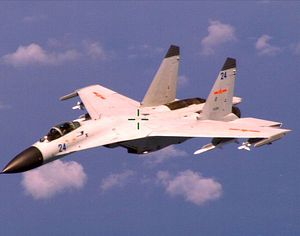Last week, Chinese state media confirmed the deployment of J-11 fighters to Woody Island, part of the disputed Paracel chain in the South China Sea. While the deployment was not unprecedented, China’s overt admission signals new confidence in its position in the region. However, in combination with recent testing of techniques for keeping the South China Sea bases supplied under combat conditions, it suggests a vulnerability to interrupted logistics.
Commercial satellite images also found J-11s on Woody Island earlier this year, but this is the first official acknowledgement of a rotational deployment there. Last year China deployed anti-ship cruise missiles and advanced air-defense missiles to the island as well.
Vietnam also claims sovereignty over the Paracel archipelago but (at the time, South Vietnam) lost control of them to China in a 1974 battle. Woody Island, which China calls Yongxing, also serves as the seat of Sansha city, which China established to politically administer all of the South China Sea islands it controls or claims.
The Paracels were not included in a 2015 claim by Chinese President Xi Jinping that China had no intention of militarizing the Spratly islands, in the southern end of the South China Sea. Nevertheless, Western analysts are sensitive to signs of increasing militarization there. The Paracels’ central location in the South China Sea provides them great potential strategic value as a base for long-range aircraft or missile batteries. Furthermore, analysts have often viewed upgrades and construction on the island as a prelude to similar expansion on the seven Spratly features that China occupies.
As a result, there are signs that U.S. strategic thinkers have given significant thought to the problems that Woody Island might pose in a potential military conflict with China, and how to neutralize it. A major fleet architecture study conducted earlier this year by the Center for Strategic and Budgetary Analysis for the U.S. Congress used an unlabeled graphic of Woody Island to illustrate new concepts for conducting amphibious raids against fortified archipelagos.
The relative isolation of China’s fortified islands in the South China Sea raises the question of how they would be supported in the event of a conflict and attempts to blockade or seize them.
Earlier in the fall, the South China Morning Post reported that a Chinese aeronautical institute tested a new unmanned aerial vehicle (UAV) that could be used to resupply China’s far-flung bases in the South China Sea and consolidate its control over the region. Based on a small turboprop plane, the UAV could deliver one and a half tons of cargo over 2,000 kilometers, far enough to reach China’s artificial facilities in the Spratly Islands. The UAV can land on short runways or rough roads and fields, or deliver its cargo by airdrop.
While the UAV may prove useful for resupplying small, austere facilities, it is probably not a solution for China’s largest South China Sea bases, or for resupply in combat conditions. The seven islands in the Spratlys that China has artificially expanded and constructed facilities each now sprawl over hundreds of acres. Some could support hundreds of personnel, and are likely intended to be logistics hubs themselves for aircraft and ships. The UAV’s one and a half-ton cargo capacity is too small to provide much more than a niche delivery capability, such as for mail or critical repair parts.
In addition to its small cargo capacity, the UAV is also unsuited to play a combat logistics role. Un-stealthy, slow, and without sophisticated radars or defensive countermeasure systems, the UAV could not be counted on to survive in a contested air environment, making them a poor choice for critical resupply in a conflict.
A more serious combat logistics capability for the South China Sea was on display last week, when four Y-9 transport planes conducted an airdrop exercise over an unidentified island. Compared to the UAV’s one and a half tons, each Y-9 can carry 25 tons of cargo nearly 8,000 kilometers. The aircraft participating in this exercise took off from China’s Western Theater Command and crossed into the Southern Theater Command, demonstrating cross-theater coordination.
Chinese state media said that the planes flew without outside weather data or headquarters guidance. This implies the aircraft flew under simulated combat conditions and with minimal, or possibly no communications to minimize the likelihood of being tracked or identified by their electronic emissions.
This sort of sustainment effort would be critical to maintaining combat-ready forces in the Paracels and in the Spratlys, though China has yet to deploy force-projection systems like ships or missiles there.
The report on this most recent J-11 deployment described special facilities and planning that made it possible, including new climate-controlled hangars to protect the jets from the heat and humidity, prolonging the time they could spend on the island. This means that Woody Island, and presumably China’s Spratly bases as well, cannot permanently support basing advanced fighters, even with the new climate-proofed facilities, highlighting both the military limitations of China’s extensive South China Sea bases, and their vulnerability to interrupted logistical support.

































